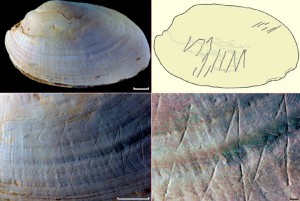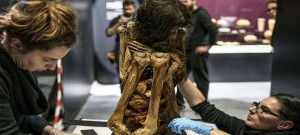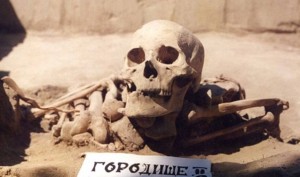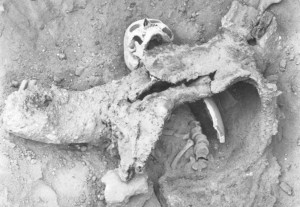500,000-Year-Old Homo erectus artwork Discovered
A multinational group of scientists led by Prof Wil Roebroeks of Leiden University in the Netherlands has uncovered the earliest known etching on a fossilized shell from the famous Homo erectus site of Trinil, on the Indonesian island of Java.
While cataloging hundreds of freshwater mussel shells composed at the end of the 19th century by the Dutch anatomist and geologist Eugene Dubois ,the discoverer of Java man, the first known fossil of Homo erectus , on the banks of the Bengawan Solo river in East Java, Prof Roebroeks and his colleagues noticed that one of the specimens was fixed.
Dr Stephen Munro from the Australian National University says “It was a Eureka moment. I could see instantly that they were man-made engravings. There was no other clarification,”
“It’s fantastic that this engraved shell has been exposed in a museum collection where it has been held for more than a hundred years,” said Prof Roebroeks, who is the senior author of the paper published in the journal Nature.
Following the discovery, the scientists worked to start the exact date of the shell, using two different methods to arrive at the final result of between 430,000 and 540,000 years old.
Dr Munro says “This is the first time we have found proof for Homo erectus behaving this way. It rewrites human record.
The Homo erectus engraving resembles the previously oldest-known engravings, which are connected with either anatomically modern Homo sapiens or Neanderthals from around 100,000 years ago.
“Until this innovation, it was assumed that comparable engravings were only made by Homo sapiens in Africa, starting about 100,000 years ago,” said Dr José Joordens of Leiden University, a team member and the lead author of the paper.
The early date and the location of the discovery on Java discount the option that the engraving could have been the work of Neanderthals or modern humans.
Dr Munro says“It puts these large bivalve shells and the tools used to score them, into the hands of Homo erectus, and will change the way we think about this early human species,”.
“The accuracy with which these early humans worked indicates great dexterity and detailed knowledge of mollusk anatomy,” said team member Dr Frank Wesselingh of the Naturalis Biodiversity Center in Leiden, the Netherlands.
It is unclear whether the model was planned as art or served some practical purpose.Prof Roebroeks says.“At the moment we have no clue about the meaning or idea of this engraving,”
“The scientists also found that Homo erectus opened the shells by drilling a hole through the shell with a shark’s tooth, accurately at the point where the muscle is attached. Injurious muscles this way causes the valves of the shell to open, so that the contents can be eaten.
Dr Munro says “It’s proof that Homo erectus exploited these aquatic food resources, and fits with other proof that they probably foraged in and around water,”
Impressive farm house dated 2,800 year old Discovered near Tel Aviv, Israel
An attractive 2,800-year-old farmhouse has been unearthed during an archaeological dig near Tel Aviv, Israel.
The large, 23-room home, which covers a 100ft x 130ft area, was build in the eighth century BC, around the time of the Assyrian defeat of Israel.
The site is thought to have a wealthy history, with Greek coins found in the house suggesting that the farmhouse was taken by different empires over the course of hundreds of years.
The leftovers of the building were discovered by the Israel Antiquities Authority (IAA) in Rosh HaAyin, east of Tel Aviv.
Several presses were found in the vicinity, suggesting that Israelis and Greeks who lived there over the years used the farm to make their own wine to sell.
Amit Shadman, the IAA’s excavation director, told the Jerusalem Post that the building was constructed about 740BC, during the time of the Assyrian defeat.
‘Farm houses during this period served as small settlements of sorts, whose population participated in processing agricultural produce,’ he explained.
The numerous wine presses exposed in the vicinity of the settlement point out the wine industry was the most significant branch of agriculture in the region.
‘A large silo, which was used to store grain, shows that the ancient populace was also engaged in growing cereal,’ Mr Shadman added.
The archaeologist said that the building sustained to be used during the Persian period, also known as the Time of the Return to Zion, in the sixth century BC.
It was also used by the Greeks when Alexander the Great came to Israel in the fourth century BC.
The exceptional, silver Greek coins establish on one of the floors of the building bear Alexander’s name. On one side of the coin is an image of Greek idol of the gods Zeus, with Heracles appearing on the other side.
‘With Alexander’s success over the Persian army in 333BC, he embarked upon several successful military campaigns,’ Mr Shadman said.
‘His campaign in Israel did not meet any special difficulties and the country opened its gates to the great warrior.
‘In light of this inspiring building’s excellent state of preservation, the Israel Antiquities Authority and Ministry of Construction decided to preserve the structure in situ for the benefit of the city’s residents and the visiting public.’
Ancient mummy ready for public display after excavation in 2012
French archaeologists are cautiously preparing the mummy, which is believed to be of a woman, ahead of a new exhibition. Archaeologists have been careful to protect and keep her in the similar foetal position.
More than 80 mummies and skeletons were found in Pachacamac, which contain infants and children who are believed to have been ritually slaughtered, in a 1,000 year-old tomb.
Beyond these amazing finds, a further 70 bodies, similar to the Peruvian mummy about to go on display were found dotted around the ritualized bodies in the tomb. Most were in a foetal position and wrapped up helping to clarify their extraordinary conservation.
The 1000-year old will now will be the Musee de Confluences where she will be part of a latest display on human death rituals and representations from special cultures and ages from throughout the globe.
Archeologists from the Université libre de Bruxelles found the 600 hectare site, which is among the most significant ancient settlement finds on par with the Machu Picchu and Nazca Lines. The people of the region, known as the Ichma, are understood to have been active in the Pachacamac area from as early as 800 AD to as late as 1450 AD.
They are considered to have constructed 17 pyramids in order to worship Pacha Kamaq, the theology that the ancient city was named for.
Scientists find earliest case of human cancer in man who died 4,500 years ago
The earliest known case of cancer has been recognized in the skeleton of a Siberian Bronze Age man. The 4,500-year-old bones have important marks and holes, alerting researchers to the devastating lung or prostate cancer that the ancient man had endured. This new proof of the illness in ancient bones demonstrates that cancer is not only a modern phenomenon, but also affected the ancient world.
The Baikal-Kokkaido Archaeological Project and research team which located the rare find was comprised of international experts, including bioarchaeologist Angela Lieverse of the University of Saskatchewan in Canada, archaeologist Vladimir Bazaliiskii of Irkutsk State University in Russia, and biological anthropologist Daniel Temple, of George Mason University in the U.S., reports The Siberian Times.
The remains of the man, dating from the Early Bronze Age, show he was 35 to 45 years of age at the time of his death. He had suffered from a cancer which increases throughout his body, the deterioration of his bones leaving him motionless. It was almost certain that those around him would have recognized he was ill. They had situated him in a circular grave in the fetal position, his knees drawn up into his chest, and he was covered with a crooked bone serpent spoon, among other items. According to CBCNews this type of burial is in contrast to other men at the time who were buried on their backs with fishing or hunting gear.
Daniel Temple told George Mason University News “The people who lived with him maybe knew something was wrong … they gave him something that symbolized illness had visited him. Grave goods have deep symbolic meaning, and when contextualized with these skeletal lesions, it is likely that the object reflected the circumstances nearby this individual’s illness and death.”
Temple also touched upon the importance of the find, saying that diagnosing a case of cancer from 4,500 years ago is related to how modern cancers are viewed. Environmental causes and industrial contaminants are often blamed as the cause of modern cancers, and while this find does not challenge that link, the current accepting of cancer can be expanded with this additional information, according to George Mason University News.
Lieverse told CBCNews of the sad fate of the ancient man as exposed by his bones, “He must have lived a distinct life in his community but he also would have skilled a most excruciating death. Near the end, he would have been nauseous, fatigued, unable to breathe and in constant pain. It’s a tragic story. It breaks your heart to think of what he went through.”
Perhaps his pain was mitigated by those around him. There is proof which suggests that pain management in ancient times was gifted through the use of natural techniques, such as herbs, or cannabis. The 2,500-year-old mummy of a woman found in 1993 in a kurgan (mound) of the Pazyryk culture in the Republic of Altai, Russia, was buried with a pouch of cannabis, usually known as marijuana. Found by her body, the Princess of Ukok may have used it to cope with the symptoms of her illness. Researchers exposed that the young woman died from breast cancer, and suffered numerous other ailments.
Archaeological proof for 1,700YearOld Chemical fighting
One of the unique features of the First World War was the widespread use of chemical arms. Chemical gases of a variety of lethality, including mustard gas, phosgene and tear gas, were used to disable and kill enemy defenders. Although chemical weapons played a major role during the Great War, its practice can be dated to a much former period of history.
One of the initial references to the use of chemical weapons in western literature can be found in the Greek myth of Heracles, in which the hero dips his arrows in the blood of the Hydra to make them toxic. It has also been claimed that resentful arrows were mentioned by Homer in both his epics, the Iliad and the Odyssey.
Records of the use of chemical weapons also show in the ancient civilizations of the East. In India, for instance, the use of poisons during warfare can be recognized in both the Mahabharata and the Ramayana. Moreover, recipes for toxic weapons can be creating in Kautilya’s Arthashastra, which dates to India’s Mauryan period. In China, there are writings that explain the use of toxic gases by defenders of a city. The toxic fumes, produced by burning balls of mustard or other toxic vegetables, are pumped into tunnels dug by a besieging army using bellows.
Returning to the Western world, the use of toxic gas may be traced to the Peloponnesian War, which took place during the 5th century B.C. During one of the battles between the Spartans and the Athenians, the former burnt a mixture of wood, pitch and sculpture under the walls of the latter, hoping that the fumes would harm the defenders, and thus disabling their ability to resist the Spartan attack.
The examples provided thus far have been obtained through the surviving literary proof. For the earliest available archaeological facts of the use of chemical weapons, however, one would need to look at the site of Dura-Europos, which is situated on the bank of the Euphrates River in Syria. Dura-Europos was a Roman city which fell to the Sassanians about the middle of the 3rd century A.D.
Although there are no fictional records about the final siege, archaeology provides a clue as to what happened. Dura-Europos was excavated during the 1920s and 30s by French and American archaeologists.
Among the features found by the archaeologists were mines, one dug by the Persians and another dig by the Romans as a counter. In addition, the piled bodies of at least 19 Roman soldiers and a lone Sassanian soldier in the tunnel were also establish.
The initial explanation was that a fierce battle ensued in the tunnel, where the Sassanians successfully repelled the Roman defenders. After the fight, the Sassanians destroyed the counter-mine by setting fire to it, as evidenced by the presence of the sulphur crystals and bitumen in the tunnel.
In 2009, a re-examination of the data led to a re-interpretation of the events that happened during the siege. As the tunnels were too narrow for effective hand-to-hand combat, doubts were cast on the established explanation.
Furthermore, the position of the Roman bodies, stacked purposely into a pile, suggests that this was not the place where they fell. The alternate interpretation, as suggested by Prof. Simon James, an archaeologist at the University of Leicester, was that the Sassanians employed toxic gases to kill the Roman defenders.
When sulphur and bitumen were thrown onto a fire, it became a choking gas, and curved into sulphuric acid when breathed in by the Roman defenders. Within minutes, the Romans who were in the dig were dead. This happened when the Sassanian mine was busted in by the Romans, whose counter-mine was right above theirs.
The lone Sassanian soldier may have been a wounded of his own weapons, and died of the poison gasses as well. Once the dig was cleared, the Sassanians stacked the Roman bodies at the mouth of the counter-mine as a shield wall, and proceeded to destroy this mine, so that they could resume their sapping work.
The archaeological finds at Dura-Europos tell that chemical warfare was previously in use during ancient times, and provides the first physical proof that the literary sources lack.




